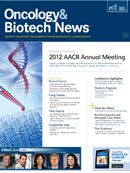Publication
Article
Oncology & Biotech News
Nab-Paclitaxel Shows Promise in Advanced Lung Cancer
Author(s):
The administration of nab-paclitaxel plus carboplatin results in a significantly higher ORR than conventional solvent-based paclitaxel with carboplatin in previously untreated patients with advanced NSCLC.
Mark A. Socinski, MD
The administration of nab-paclitaxel plus carboplatin results in a significantly higher overall response rate (ORR) than conventional solvent-based paclitaxel with carboplatin in previously untreated patients with advanced non—small cell lung cancer (NSCLC), according to the results of a phase III study. NSCLC is the number one cause of cancer-related death in the United States, with only 1% of patients with stage IV disease remaining alive at 5 years, the authors wrote.
The data also showed that nab-paclitaxel, which is a 130-nm albumin-bound formulation of paclitaxel, was well-tolerated despite a higher cumulative paclitaxel dose when administered without premedication.
Mark A. Socinski, MD, University of Pittsburgh Medical Center, Pennsylvania, and colleagues randomized 1052 patients to one of two treatment regimens as first-line therapy for nonresectable stage IIIB (with or without pleural effusion) or stage IV NSCLC.
One group of patients received 100 mg/m2 30-minute infusions of nab-paclitaxel on days 1, 8, and 15 followed by carboplatin area-under-the-concentration time curve (AUC) 6 mg/mL/min on day 1 every 3 weeks, while the other group received 200 mg/m2 3-hour infusions of solvent-based paclitaxel plus carboplatin at AUC6, both given every 3 weeks.
The study’s primary efficacy endpoint was ORR by independent radiology assessment. Nab-paclitaxel demonstrated a significantly higher ORR than solvent-based paclitaxel (33% vs 25%; response rate ratio, 1.313; 95% CI, 1.082-1.593; P = .005).
Results also showed a significant improvement in ORR for nab-paclitaxel versus solvent-based paclitaxel in patients with squamous cell histology (41% vs 24%; response rate ratio, 1.680; 95% CI, 1.271-2.221; P <.001). However, the two treatments were similarly effective in patients with nonsquamous histology (26% vs 25%; response rate ratio, 1.034; 95% CI, 0.788-1.358; P = .808).
The investigators reported that the 68% improvement in the squamous cell histology group treated with nab-paclitaxel versus solvent-based paclitaxel arm is the highest reported thus far in a phase III trial in this patient population. The finding is noteworthy given the need for better therapeutic options in patients with squamous cell histology.
The investigators also documented a roughly 10% improvement for progression-free survival and overall survival in the nab-paclitaxel arm. The nab-paclitaxel regimen was associated with less severe neuropathy, neutropenia, myalgia, and arthralgia than solvent-based paclitaxel.
Patients receiving the nab-paclitaxel regimen had a higher risk of anemia and thrombocytopenia, but these side effects were usually manageable. The investigators said that, overall, the results suggest that the nab-paclitaxel regimen has a favorable risk-benefit profile compared with solvent-based paclitaxel when given as first-line therapy in patients with NSCLC.
Socinski MA, Bondarenko I, Karaseva NA, et al. Weekly nab-paclitaxel in combination with carboplatin versus solvent-based paclitaxel plus carboplatin as first-line therapy in patients with advanced non—small-cell lung cancer: final results of a phase III trial [published online ahead of print April 30, 2012]. J Clin Oncol. doi: 10.1200/JCO.2011.39.5848.









